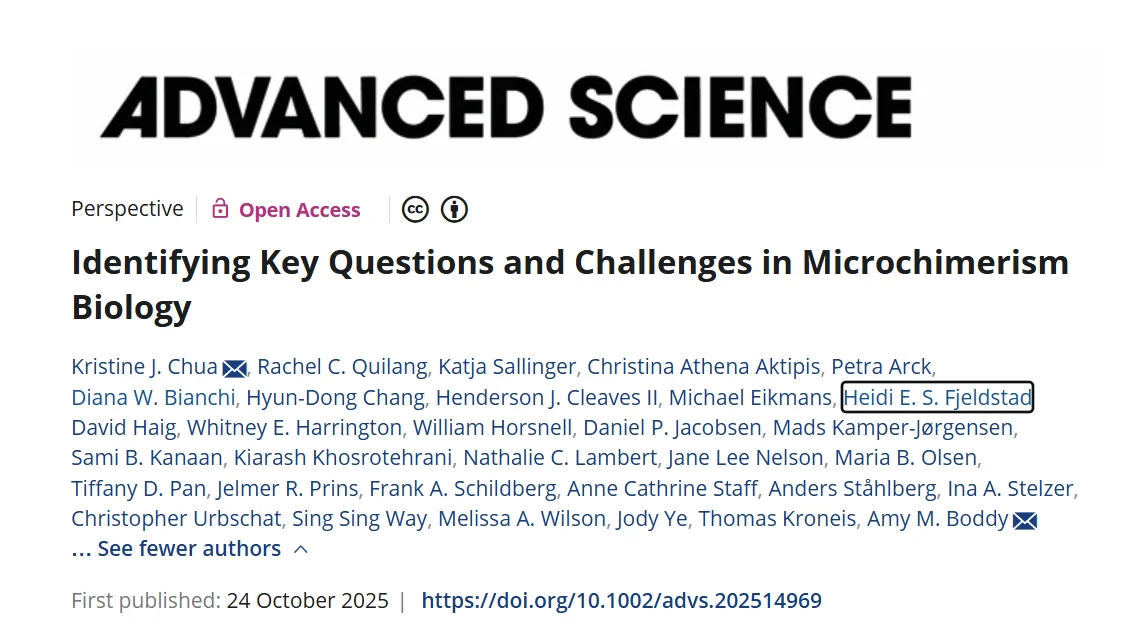
Ada Hang-Heng Wong: The Hidden Biology of Microchimerism in Pregnancy and Beyond
Ada Hang-Heng Wong, Deputy Editor for Advanced Science Oncology Section at Wiley, shared a post on LinkedIn about a paper by Kristine J. Chua et al. published in Advanced Science:
“Microchimerism
A chimera is defined as an organism containing cells of multiple genetic origins. The injection of engineered embryonic stem cells into blastocysts to create transgenic mice often results in chimeric mice with unpredictable outcomes. Breeding is commonly used to screen for germline modifications that are inherited by offspring. However, it is rare to examine the phenotypes of chimeras, let alone the biology of chimerism itself, especially when this form of chimerism is artificially induced.
Nevertheless, microchimerism arising during pregnancy deserves greater attention. In particular, dissecting the biology of fetal microchimerism may provide insight into fetal mortality. Studying maternal microchimerism could shed light on postpartum autoimmune diseases, whereas investigating intergenerational microchimerism may reveal additional benefits of lactation. Finally, the concept of transgenerational microchimerism challenges our understanding of genetic inheritance through meiosis and embryogenesis.
UC Santa Barbara’s anthropologist Amy Boddy discussed many questions raised by experts in the field and calls for interdisciplinary collaboration to develop methodologies for studying microchimerism biology in this insightful perspective published by Advanced Science.
Original Perspective.
Photo courtesy of Prof. Chuxia Deng and Dr. Kai Miao of Universidade de Macau / University of Macau”
Title: Identifying Key Questions and Challenges in Microchimerism Biology
Authors: Kristine J. Chua, Rachel C. Quilang, Katja Sallinger, Christina Athena Aktipis, Petra Arck, Diana W. Bianchi, Hyun-Dong Chang, Henderson J. Cleaves II, Michael Eikmans, Heidi E. S. Fjeldstad, David Haig, Whitney E. Harrington, William Horsnell, Daniel P. Jacobsen, Mads Kamper-Jørgensen, Sami B. Kanaan, Kiarash Khosrotehrani, Nathalie C. Lambert, Jane Lee Nelson, Maria B. Olsen, Tiffany D. Pan, Jelmer R. Prins, Frank A. Schildberg, Anne Cathrine Staff, Anders Ståhlberg, Ina A. Stelzer, Christopher Urbschat, Sing Sing Way, Melissa A. Wilson, Jody Ye, Thomas Kroneis, Amy M. Boddy
Read the full article.

Stay updated on all scientific advances in the field of fertility with Fertility News.
-
Oct 11, 2025, 06:44The Global IVF Market Is Set to Reach $65B by 2032 – Meddilink
-
Dec 20, 2025, 10:57Clare Pin-Chia Huang: New Research Links Maternal Diabetes to Pregnancy Risks
-
Dec 20, 2025, 10:53Evaluating Maternal and Neonatal Health in Rheumatoid Arthritis Pregnancies – Hiroki Ozawa
-
Dec 20, 2025, 10:36Enhancing Care for Women Facing Recurrent Pregnancy Loss – SOGC
-
Dec 20, 2025, 05:00Ilana Ferhadian: Celebrating Book Launch
-
Dec 19, 2025, 16:21Launch of National Fertility Plan Marks Public Health Milestone – Collectif BAMP Association
-
Dec 18, 2025, 13:55Insights from Cendrine Siraudin on Fertility Support – Destination Santé
-
Dec 18, 2025, 13:34Alberto Sifuentes Giraldo: Key Insights on Antiphospholipid Syndrome From Recent Study
-
Dec 18, 2025, 13:28New Webinar on Managing Bipolar Disorder in Perinatal Patients – The Periscope Project Perinatal Specialty Consult Psychiatry
-
Dec 18, 2025, 13:16New Score Quantifying Disease Activity in Patients With Antiphospholipid Syndrome – EULAR
